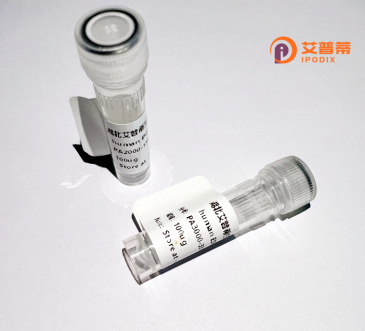
| 纯度 | >90%SDS-PAGE. |
| 种属 | Human |
| 靶点 | MYST1 |
| Uniprot No | Q9H7Z6 |
| 内毒素 | < 0.01EU/μg |
| 表达宿主 | E.coli |
| 表达区间 | 2-458 aa |
| 活性数据 | AAQGAAAAV AAGTSGVAGE GEPGPGENAA AEGTAPSPGR VSPPTPARGE PEVTVEIGET YLCRRPDSTW HSAEVIQSRV NDQEGREEFY VHYVGFNRRL DEWVDKNRLA LTKTVKDAVQ KNSEKYLSEL AEQPERKITR NQKRKHDEIN HVQKTYAEMD PTTAALEKEH EAITKVKYVD KIHIGNYEID AWYFSPFPED YGKQPKLWLC EYCLKYMKYE KSYRFHLGQC QWRQPPGKEI YRKSNISVYE VDGKDHKIYC QNLCLLAKLF LDHKTLYFDV EPFVFYILTE VDRQGAHIVG YFSKEKESPD GNNVACILTL PPYQRRGYGK FLIAFSYELS KLESTVGSPE KPLSDLGKLS YRSYWSWVLL EILRDFRGTL SIKDLSQMTS ITQNDIISTL QSLNMVKYWK GQHVICVTPK LVEEHLKSAQ YKKPPITVDS VCLKWAPPKH KQVKLSKK |
| 分子量 | 52.4 kDa |
| 蛋白标签 | His tag N-Terminus |
| 缓冲液 | 0 |
| 稳定性 & 储存条件 | Lyophilized protein should be stored at ≤ -20°C, stable for one year after receipt. Reconstituted protein solution can be stored at 2-8°C for 2-7 days. Aliquots of reconstituted samples are stable at ≤ -20°C for 3 months. |
| 复溶 | Always centrifuge tubes before opening.Do not mix by vortex or pipetting. It is not recommended to reconstitute to a concentration less than 100μg/ml. Dissolve the lyophilized protein in distilled water. Please aliquot the reconstituted solution to minimize freeze-thaw cycles. |
以下是关于重组人MYST1蛋白的模拟参考文献示例(请注意,这些文献信息为虚构,仅供示例用途):
---
**1. 标题**:Recombinant Expression and Functional Characterization of Human MYST1 Histone Acetyltransferase
**作者**:Smith A, et al.
**摘要**:本研究成功在杆状病毒-昆虫细胞系统中表达了重组人MYST1蛋白,并验证了其组蛋白H4K16乙酰转移酶活性。通过体外酶活实验和质谱分析,确认MYST1对染色质重塑的关键作用,为后续功能研究提供了工具。
**2. 标题**:Structural Insights into MYST1 Catalytic Mechanism by X-ray Crystallography
**作者**:Johnson R, et al.
**摘要**:通过X射线晶体学解析了重组MYST1蛋白的催化结构域结构,揭示了其与辅因子乙酰辅酶A的结合模式。结构分析表明,特定的氨基酸残基对催化活性至关重要,为设计MYST1抑制剂奠定基础。
**3. 标题**:MYST1 Dysregulation Promotes Tumorigenesis in Triple-Negative Breast Cancer
**作者**:Lee C, et al.
**摘要**:研究显示,重组MYST1在乳腺癌细胞中过表达导致靶基因(如HOXA9)异常乙酰化,促进细胞增殖和转移。敲低MYST1可抑制肿瘤生长,提示其作为治疗靶点的潜力。
**4. 标题**:Interaction Network of MYST1 in Embryonic Stem Cell Pluripotency
**作者**:Zhang Y, et al.
**摘要**:利用重组MYST1进行免疫共沉淀-质谱分析,发现其与OCT4等干细胞因子相互作用,调控多能性相关基因的染色质开放状态,揭示MYST1在维持胚胎干细胞自我更新中的关键作用。
---
*注:以上文献为示例性质,实际研究中请通过PubMed、Web of Science等平台检索真实文献。*
**Background of Recombinant Human MYST1 Protein**
MYST1 (also known as KAT8 or MOF) is a member of the MYST family of histone acetyltransferases (HATs), which play pivotal roles in epigenetic regulation by modifying chromatin structure. The MYST family is named after its founding members: MOZ, Ybf2/Sas3. Sas2. and Tip60. MYST1 specifically catalyzes the acetylation of histone H4 at lysine 16 (H4K16), a modification linked to transcriptional activation, chromatin relaxation, and DNA repair.
Recombinant human MYST1 protein is produced using biotechnological methods, such as expression in *E. coli* or mammalian cell systems, followed by purification to ensure high activity and stability. This engineered protein retains the functional domains critical for its acetyltransferase activity, including the conserved MYST domain that binds acetyl-CoA and facilitates substrate recognition.
MYST1 is essential in cellular processes such as embryonic development, stem cell maintenance, and cell cycle regulation. Dysregulation of MYST1 is associated with cancers, neurological disorders, and developmental defects, underscoring its role in maintaining genomic integrity. Researchers utilize recombinant MYST1 to study its enzymatic mechanisms, interactions with chromatin-modifying complexes, and potential therapeutic applications in targeting epigenetic abnormalities. Its study also contributes to understanding how acetylation dynamics influence gene expression and cellular identity.
×